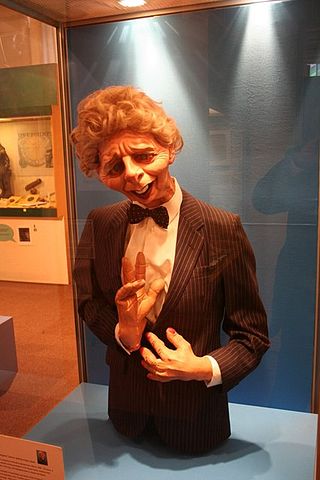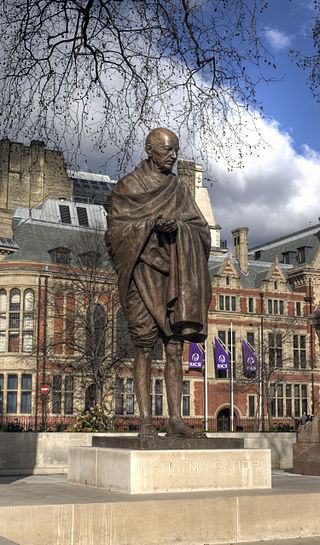
Marc Quinn is a British contemporary visual artist whose work includes sculpture, installation, and painting. Quinn explores "what it is to be human in the world today" through subjects including the body, genetics, identity, environment, and the media. His work has used materials that vary widely, from blood, bread and flowers, to marble and stainless steel. Quinn has been the subject of solo exhibitions at Sir John Soane's Museum, the Tate Gallery, National Portrait Gallery, Fondation Beyeler, Fondazione Prada, and South London Gallery. The artist was a notable member of the Young British Artists movement.

Sir William Hamo Thornycroft was an English sculptor, responsible for some of London's best-known statues, including the statue of Oliver Cromwell outside the Palace of Westminster. He was a keen student of classical sculpture and was one of the youngest artists to be elected to the Royal Academy, in 1882, the same year the bronze cast of Teucer was purchased for the British nation under the auspices of the Chantrey Bequest.
The year 2002 in art involves various significant events.

John Henry Foley, often referred to as J. H. Foley, was an Irish sculptor, working in London. He is best known for his statues of Daniel O'Connell in Dublin, and of Prince Albert for the Albert Memorial in London and for a number of works in India.

The Members' Lobby is a hallway in the Palace of Westminster used by members of the House of Commons, the lower house of the Parliament of the United Kingdom. Members of Parliament may congregate here for discussions while not dealing with other business.

The statue of Queen Victoria by Joseph Edgar Boehm stands on College Green, Bristol, England. It is Grade II listed.

Margaret Thatcher was Prime Minister of the United Kingdom from 1979 to 1990. Her portrayal in the arts and popular culture has been mixed. In the words of one critic she attracted "musical opprobrium like no other British political leader". Such opinion is divergent from mainstream opinion polling which tends to place her as the most popular British prime minister since Winston Churchill.

The fourth plinth is the northwest plinth in Trafalgar Square in central London. It was originally intended to hold an equestrian statue of William IV, but remained empty due to lack of funds. For over 150 years, its use was debated; in 1998, the Royal Society for the encouragement of Arts, Manufactures and Commerce (RSA) commissioned three contemporary sculptures to be displayed temporarily on the plinth. Shortly afterwards, Chris Smith, Secretary of State for Culture, Media and Sport, commissioned Sir John Mortimer to seek opinions from public art commissioners, critics and members of the public as to its future. Mortimer's final report recommended that there continue to be a rolling programme of commissioned temporary artworks rather than settle permanently on one figure or idea.

A statue of Margaret Thatcher, the first female prime minister of the United Kingdom, stands in the Members' Lobby of the Houses of Parliament in London. It is a bronze sculpture of Margaret Thatcher, the first female Prime Minister of the United Kingdom. It was commissioned in 2003 following a change in rules to allow the depiction of living prime ministers in Parliament under certain conditions. The bronze statue, sculpted by Antony Dufort, was unveiled on 21 February 2007 by Michael Martin, Speaker of the House of Commons, with Thatcher in attendance.

The statue of the Earl Kitchener is an outdoor bronze statue by John Tweed depicting Herbert Kitchener, 1st Earl Kitchener, installed in 1926 and located on the south side of Horse Guards Parade in London, United Kingdom. The sculpture stands on a Portland stone plinth. It became a Grade II listed building in 1970.

The statue of Winston Churchill is a standing bronze statue of statesman and writer Winston Churchill, situated in the Members' Lobby of the House of Commons of the United Kingdom, part of the Palace of Westminster complex in Westminster, Central London. Churchill is depicted mid-stride, with his hands on his hips.

A bronze statue of Admiral of the Fleet Louis Mountbatten, 1st Earl Mountbatten of Burma is located on Mountbatten Green, off Horse Guards Road, Whitehall, London, England. The sculptor was Franta Belsky and the work was cast by the Meridian Bronze Foundry. The memorial was unveiled on 2 November 1983.

Douglas Jennings MRSS is an English sculptor and a Member of the Royal Society of Sculptors.

The statue of Mahatma Gandhi in Parliament Square, Westminster, London, is a work by the sculptor Philip Jackson.

The statue of Millicent Fawcett in Parliament Square, London, honours the British suffragist leader and social campaigner Dame Millicent Fawcett. It was made in 2018 by Gillian Wearing. Following a campaign and petition by the activist Caroline Criado Perez, the statue's creation was endorsed by both the Prime Minister of the United Kingdom, Theresa May, and the Mayor of London, Sadiq Khan. The statue, Parliament Square's first monument to a woman and also its first sculpture by a woman, was funded through the government's Centenary Fund, which marks 100 years since some women won the right to vote. The memorial was unveiled on 24 April 2018.
The year 2020 in art involved various significant events.

Self Sacrifice, better known as the Lady Godiva statue is an equestrian statue of Lady Godiva in Broadgate, Coventry. The statue is bronze, on a plinth of Portland stone.

A statue of Margaret Thatcher stands in her birthplace, the town of Grantham in Lincolnshire, England. The statue is 10 feet 6 inches (3.2 m) high, cast in bronze, and depicts the late British prime minister Baroness Thatcher, dressed in the full ceremonial robes of the House of Lords. It stands on a 10-foot-6-inch (3.2 m) plinth. Created by sculptor Douglas Jennings, and costing £300,000, it was erected on 15 May 2022, on St Peter's Hill Green, close to the Grantham Museum. Eggs were thrown at the statue within two hours of its installation, and a week later red paint was thrown at it. It was formally unveiled on 31 May.
Antony Dufort FRSS is an English artist and sculptor. Commissioned works stand in locations in Britain.

















